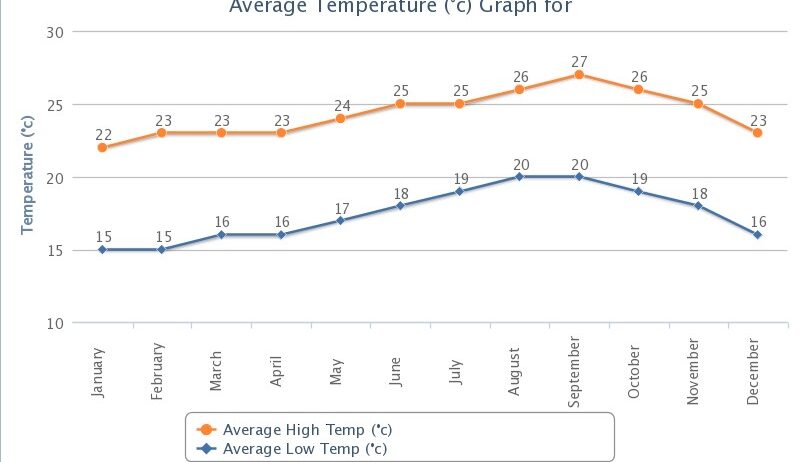The African continent, often likened to a vast tapestry of climate zones, is a veritable microcosm of Earth’s meteorological diversity. From the blistering Sahara Desert, where the sun reigns supreme, to the lush, verdant expanses of the Equatorial region, Africa’s climate is an intricate interplay of extremes. Understanding this climatic symphony is essential to appreciating the continent’s ecological and cultural richness.
The Sahara Desert, an unyielding behemoth, represents one of the most stark climatic realities on the planet. Covering approximately 3.6 million square miles, it is a formidable entity that stretches from the Atlantic Ocean in the west to the Red Sea in the east. The Sahara is characterized by its arid conditions, with annual rainfall averaging less than three inches in many areas. This parched environment is akin to an unforgiving canvas, where life is perpetually challenged to adapt and survive. Centuries of evolution have given rise to resilient flora and fauna, including the iconic dromedary camel, which effortlessly navigates the shifting sands with grace.
Within this arid expanse, temperature fluctuations create an astonishing dynamic. During the day, the sun scorches the earth, with temperatures soaring above 120 degrees Fahrenheit (49 degrees Celsius). Nights, however, offer a stark contrast; the mercury plunges dramatically, sometimes dipping into the low 40s Fahrenheit (around 5 degrees Celsius). This diurnal temperature variation serves as a reminder of the Sahara’s dual nature—both harsh and beautiful, relentless yet serene.
As we traverse southward, we encounter the Sahel—an ecological transition zone that gently ushers in a more temperate climate. Here, the desert gives way to a region marked by semi-arid conditions and sporadic rainfall. The Sahel, often visualized as a thin strip of land, is a strategic battleground for combatting desertification and fostering agricultural resilience. The annual rainfall ranges from eight to twenty inches, necessitating innovative farming techniques that defy climatic constraints.
Crossing the threshold into West and Central Africa, we behold the marvels of the tropical rainforest climate. This dichotomy, with its abundant precipitation and high humidity, is a stark contrast to the Sahara’s barrenness. Equatorial regions witness the symphony of rainfall—varying between 40 to 100 inches annually—creating an abundant habitat for a myriad of species. The rainforest, adorned with colossal trees and vibrant flora, is not merely a biome; it is a sanctuary of biodiversity, where the cacophony of life resonates through the canopies.
The climate of these regions is dictated by the intertropical convergence zone (ITCZ), an atmospheric phenomenon that dictates the seasonal rains. The ITCZ oscillates, drawing moisture-laden winds from the ocean. When this celestial dance aligns, the result is an explosive growth of plant life and a thriving ecosystem. The interplay of sunlight, rainfall, and temperature creates an ecological tapestry that is both delicate and resilient.
Yet, Africa’s climate is not merely a backdrop for its remarkable biodiversity. It plays a pivotal role in shaping the socio-economic fabric of the continent. The livelihood of millions hinges on understanding climate patterns. Agriculture, the lifeblood of many nations, thrives in regions where rainfall is adequate and predictable. Conversely, the arid lands of the Sahara and Sahel present formidable challenges, requiring innovative solutions and sustainable practices to harness resources wisely.
Climate change, an omnipresent specter, adds another layer of complexity to Africa’s climatic narrative. The continent is often portrayed as a battleground for climate resilience, as it grapples with erratic weather patterns, extended droughts, and increased flooding. This double-edged sword underscores the need for adaptation and mitigation strategies, particularly in vulnerable areas. The struggles of subsistence farmers and nomadic herders exemplify the urgent need for comprehensive environmental policies that acknowledge the intricate relationship between climate, culture, and community.
The coastal regions of Africa introduce yet another dimension to the landscape of climate. The Mediterranean climate found in the northern reaches, characterized by mild, wet winters and hot, dry summers, presents challenges and opportunities. This climate, often likened to a temperamental artist, offers rich soils conducive to agriculture and viticulture but also demands caution against the increasing specter of drought and water scarcity. In contrast, the Indian Ocean coast experiences a tropical maritime climate where monsoons dictate the rhythm of life. The monsoonal rains breathe vitality into the coastal ecosystems, making them unparalleled in beauty.
In juxtaposition, the uplifted terrains of the East African Highlands stand as a testament to Africa’s geological dynamism. Here, altitude dictates climate, leading to cooler temperatures and an abundance of rainfall in regions such as Mount Kilimanjaro. These majestic heights serve as a refuge for unique species and are also critical watersheds for surrounding communities, emphasizing the interconnectedness of climate systems.
In conclusion, the climatic tapestry of Africa is a vivid reflection of the continent’s geological and biological diversity. Each climate zone—from the parched expanses of the Sahara to the luxuriant rainforests of the Equatorial regions—contributes to an intricate web of life and livelihood. As the continent continues to adapt to the evolving challenges posed by climate change, it remains an exemplar of resilience and innovation. Understanding the nuances of Africa’s climate is not merely an academic exercise; it is a profound exploration of our shared planet and the urgent responsibility to protect its wonders.








